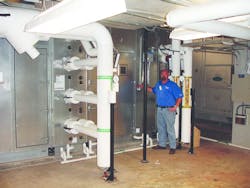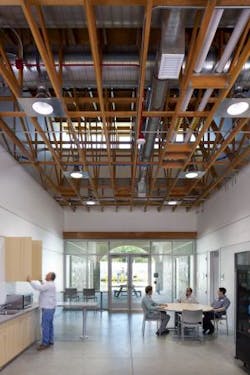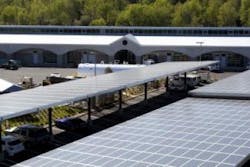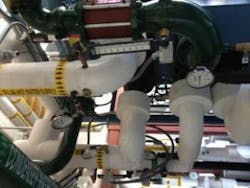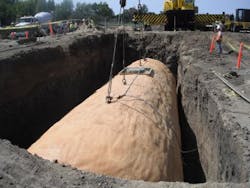Energy Management's Role in Commercial HVAC Projects
Energy management. Everyone in HVACR circles is talking about it, thinking about how to apply new methods to their service and installation offerings, or practicing it, to the mutual benefit of contractor and building owners. Energy managment strategies have become impossible to ignore. As energy grids are stretched to their limits, and building owners demand lower maintenance costs, it’s up to building designers, engineers, and HVAC contractors to provide start-to-finish solutions.
Al Kuhnemann, sales manager for Brady, Greensboro, NC, points to four energy management motivators that are influencing contractors and their customers.
1. Code compliance. Kuhnemann says increasing numbers of building owners, who are expected to follow state mandates for meeting energy standards, expect their installing and servicing contractors to be ready with ideas for reducing energy costs.
“The State of North Carolina, for example, has implemented an energy conservation code, as has California with Title 24 for energy requirements. When a state issues a building code, it naturally gets rolled into all of the thought processes of people in construction or renovation,” Kuhnemann says. “Everybody in the chain — from the contractor, to the engineer, to the architect and building owner — are automatically asking whether their projects will meet compliance.”
That awareness is guided by industry “beacons,” such as LEED or EnergyStar, which are used to measure their program’s effectiveness.
“People are looking at doing the right thing for the environment. I call this the ‘People, Planet, and Profit’ approach,” Kuhnemann says.
If people protect the environment and others, then the bottom line profit will come.
"For example, Trane’s ‘EarthWise’ approach means we look at everything in the context of, ‘is it going to be more energy efficient? Will it reduce carbon dioxide emissions and will it be sustainable?" he explains.
3. Energy rebates. Energy providers across the U.S., such as North Carolina’s Duke Power and Progress Energy are also providing an impetus to the newest energy trends.
“They’re looking at not having to build new power plants, if in fact we’re more cautious and judiciously using the energy they make now,” Kuhnemann says. “Their programs are huge drivers. They have significant rebate programs based on using energy efficient equipment that helps to offset the price difference. They also provide apparatus at reduced prices, such as lighting, to prompt what we call relamping or delamping, where we use more efficient lighting.”
Performance contracts are another strategy. Here, the building owner uses the energy savings that will accrue from new equipment or changes to pay for new equipment. “At the Museum of Art in Raleigh, NC, Brady implemented the state’s very first performance contract. The museum is saving more than $600,000 per year in energy savings, and they’re using those savings to pay for the installation,” Kuhnemann says. (Seebit.ly/Bradymuseumproject.)
4. Documentation. This is the proof that the stated energy savings is actually occurring. “It’s more of a measurement and verification activity,” Kuhnemann explains. “Energy organizations are measuring if you’re actually increasing energy efficiency, reducing emissions, and improving sustainability. As the saying goes, ‘if you can’t measure something, it’s very hard to manage it.’”
Among the actual mechanical trends Kuhnemann sees as most popular is Btu management. “Literally, it’s how the Btus are moved around inside a building,” he says. “Instead of moving heat outside, we’re taking those BTHUs across the system, to a hot water tank, and putting them to use in heating water. This saves on boiler capacity, and natural gas, and electricity is spared.
Another key mechanical development, though not new, is continued proliferation of higher efficiency equipment. “In 1968, chillers would use .85 kW per ton. Now, our industry has chillers that will provide a ton of refrigeration at .45 kW per ton. Manufacturers are making higher efficiency equipment available to engineers and installers,” Kuhnemann says.
Kuhnemann also singles out great advances in intelligent control systems. “You can buy it, install it, maintain it, but you might not be controlling it properly. So if I have a 100-ton system in a building, but only 50-tons are being used due to occupancy, why not cut that back to a 50-ton delivery. Why, at night should I continue cooling an empty building down to 72F?. Why not set it up to 80F overnight, then lower it in the morning? This ties in with improved control strategies. If you have a conference room with 500 occupants, you have to design the air conditioning for that maximum load. If the next meeting in that room has only 100 people, a CO2 sensor can be used to count the occupancy volume (PPM of CO2), so it sends a signal to slow down the air conditioning. We’re also seeing that more and more people are investigating renewables, such as geothermal, solar, biomass, wind, and ice storage for off-peak heating and cooling,” Kuhnemann says.
Kuhnemann says hospitals and schools are among the best building candidates for energy management makeovers. “Hospitals and schools are continuously challenged with budget and operating constraints, and serve as great candidates for applying these energy trends and processes. And we’re also seeing a small uptick in interest among manufacturing sites.”
Working Together for Energy Goals
The Pierce College M & O Building in Los Angeles, CA is an example of a recent energy-based project that required collaboration by all parties. The project has been “LEED gold certified.”
The mechanical systems were installed by Southland Industries, Garden Grove, CA. Southland's team provided Design/Build HVAC and plumbing services for a 42,000 sq.ft. maintenance office, shop building and a new, near net-zero central plant. Southland Industries’ work included the installation of 4,800 solar thermal evacuated tube collectors, a massive 42,000-gal. underground solar hot water storage tank and solar thermal piping. The near net-zero design uses solar thermal power to generate heating and cooling for the new M&O building and horticultural buildings.
The infrastructure provided future solar thermal evacuated tube collectors and expansion provisions for a total of 189 kW of photovoltaic panels.
Leading the project was Don Harrisberger, principal engineer for Southland Industries. “After we were awarded the project the district became interested in doing some sort of energy efficiency project, and make it a statement to the community that they’re sustainability-minded, and pushing the envelope in trying to be energy efficient. So we worked closely with the district in trying to develop what type of systems and technology we could apply to it," Harrisberger says.
The photovoltaic solution helped to reduce electrical demand for plug loads and lighting. A challenge, however, was in developing a way to pull the HVAC system off of the grid. “The solar thermal collectors provided a solution. The solar thermal collectors provide about 200F to 210F temperature water that helps drive the absorption chillers for the building, and serve as a heating source,” Harrisberger explains.
Harrisberger say the biggest challenge was in integrating the various systems. “We have times when we could be storing energy, using energy, cooling, heating, many scenarios. We looked at all of those scenarios and realized we had to integrate it at the base level, rather than make it a sophisticated system that may have been difficult to build and operate.
The new systems include Thermax absorption chillers, Trane air handlers and Lochinvar boilers. Solar collectors and panels were provided by Sunda, and Alerton controls keep everything clicking.
Harrisberger believes all HVAC contractors should be looking at renewable energy sources, and might play a role in the design phase.
A key is reducing the load of the building at the beginning. Work with the architect or owner to ensure the building has proper insulation, glass, shading, all the things that help to reduce the load. Then you look at the equipment that’s available to help you build a more energy efficient building. We do that by running energy analysis through software, looking at utility rates, to figure out the operating cost and potential payback.
Southland Industries recently announced a new energy services division, Southland Energy. Backed by Southland Industries’ more than 60 years of experience in designing, building, operating and servicing high-performance facilities, Southland Energy guarantees performance on a wide range of projects, including those that are the most complex.
“Our in-house capability to self-perform the vast majority of the work required for complex energy solutions ultimately drives down costs for the owner,” says Natasha Shah, Southland Industries vice president of energy services. “Our approach enables customers to avoid the multi-tiered markups that result from other ESCOs subcontracting most of the work,” Shah says.

